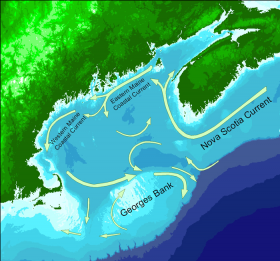The Gulf of Maine extends from Cape Cod in Massachusetts, to the coasts of New Hampshire, Maine, and the Canadian provinces of New Brunswick, and to Cape Sable, Nova Scotia.
An important part of the Gulf is Casco Bay, which supports substantial varieties of marine life, but is in the midst of the highest concentration of population in the state, and is thus vulnerable to threats from human caused pollution and runoff.
The map at right shows currents in the Gulf. Named portions of the counterclockwise currents are labeled and depth measurements are shown, with darker blues representing deeper water.
The nutrient rich waters of the Gulf are fed primarily by the cold, deep Labrador Current, which helps drive the primarily counterclockwise circulation of the Gulf. These currents are influenced by fluctuations in river outflow, often enhanced during spring runoff. Water exits the Gulf primarily through the Great South Channel, between Cape Cod and Georges Bank, approximately three months after entering.
The abundance of marine species was a major attraction for the early visitors from Europe – fishermen. Soon explorers arrived seeking riches in the New World, finding less gold and more fish.
The Gulf’s currents have a major impact on biological diversity and abundance that supports Maine’s commercial fisheries through the distribution of nutrients, plankton, larvae. They also carry invasive species, toxins and human generated wastes that threaten those fisheries. Changes in the strength and direction of the Eastern Maine Coastal Current influences the occurrence of poisonous “Red Tide” in western Maine. This can result in the state closing tidal flats for public safety, causing damage to the important shellfish harvesting industry.
Here is an excerpt fom the Gulf of Maine Habitat Primer cited below:
Salt marshes, seagrass beds, tidal mud flats, underwater rocky outcrops, kelp beds, and other marine and estuarine habitats are building blocks of the Gulf of Maine ecosystem. These habitats provide homes for the animals, plants, and microbes that inhabit the coastal and offshore waters, depending on each other and the environment for food, shelter, and the other necessities of life. Intact marine habitats in the Gulf of Maine support productive fisheries and serve a host of other functions such as cycling nutrients, filtering pollution, trapping sediments, storing carbon, buffering upland areas from storm damage, and providing recreation opportunities.
The Gulf of Maine has supported a long tradition of fishing, marine transportation, coastal development, and recreation, and these human activities have affected habitat integrity. Effective management and regulation is imperative for the continued functioning of the ecosystem and economic prosperity of the region, particularly given the growing variety and intensity of human uses. Existing and proposed uses of Gulf of Maine habitats include aquaculture, wind farms, fishing, sand mining, pipelines, cables, docks, piers, sewage outfalls, and discharge of pollutants—all of which can alter the natural functions of habitats.
Consequently, managing the natural resources of the Gulf of Maine and its coastline . . . requires a broad understanding of habitat types, distributions, ecological functions, and the potential human effects on habitat.
Additional resources
*Credit: Map and Data from Ocean Modeling Group, School of Marine Sciences, University of Maine.
“About the Gulf.” http://www.gulfofmaine-census.org/about-the-gulf/ (accessed March 10, 2013)
Action Plan, 2007-2012. Augusta, Me. Gulf of Maine Council on the Marine Environment. 2007.
McKenna, James E. Potential Impacts of Cultured Atlantic Salmon on Aquatic Resources in the Gulf of Maine: A Synthesis of the Literature. U.S. Fish and Wildlife Service?, 1995.
Nenadovic, Mateja. The Process of Implementing the Western Gulf of Maine Area Closure: The Role and Perception of Fisher’s Ecological Knowledge. Augusta, Me. State of Maine. Department of Marine Resources. 1983.
Pappal, Adrienne. Marine Invasive Species: State of the Gulf of Maine Report. Gulf of Maine Council on the Marine Environment. 2010.
Platt, Davis (ed.) Rim of the Gulf: Restoring Estuaries in the Gulf of Maine. Rockland, Me. Island Institute. c1998.
Rich, Walter Herbert. Fishing Grounds of the Gulf of Maine. Augusta, Me. State of Maine. Department of Marine Resources. 1983.
Temperature and Salinity Atlas for the Scotian Shelf and the Gulf of Maine [electronic resource] Dartmouth, N.S. : Fisheries and Oceans Canada, 1996.
Tyrrell, Megan C. Gulf of Maine Marine Habitat Primer. Maine Gulf of Maine Council on the Marine Environment. 2005. (quote from the Introduction, pp. 1-2.)
Waring, Dean J. The U.S.-Canadian Boundary Dispute in the Gulf of Maine: A Canadian Perspective. Publisher 1980. (Thesis (Honors)–University of Maine, 1980)
York, Charlie, 1887-1962. Charlie York, Maine Coast Fisherman. Camden, Me. International Marine Publishing Co. 1974.


